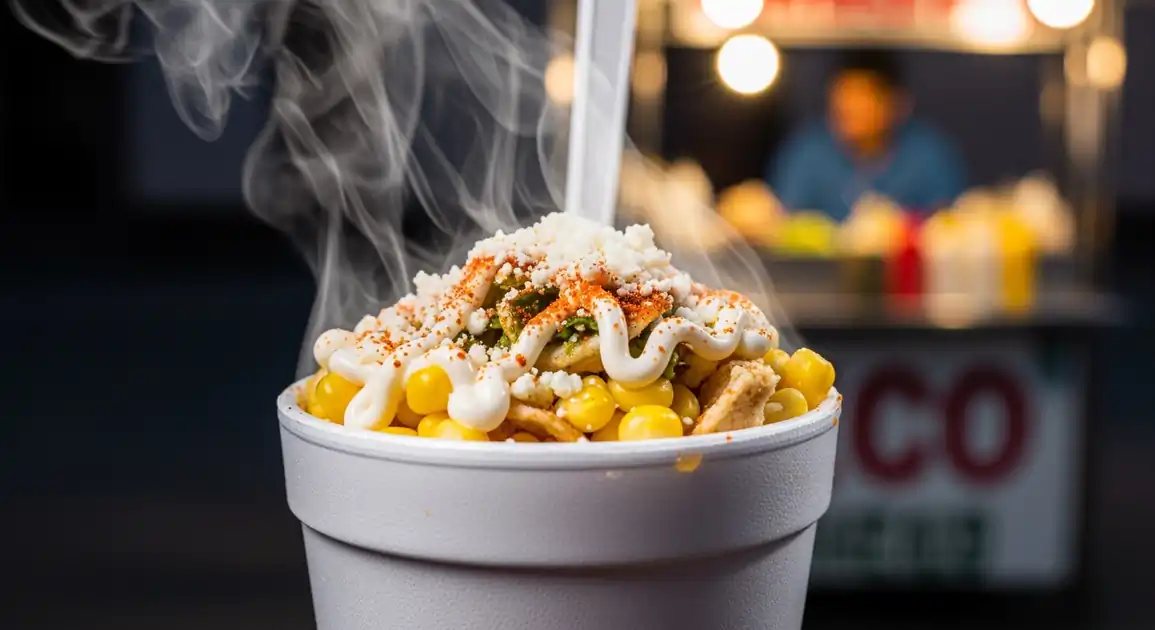Esquites (Mexican Corn Salad/Cup)
Esquites

Description
Esquites are a ubiquitous street food found across Mexico, especially popular in the central regions. While the core ingredients remain similar, regional variations in name, type of corn, chili used, and occasional unique additions exist. It's primarily an evening and late-night snack.
Dietary Information
Serving information
Serving style
Served hot in a disposable cup (styrofoam or plastic) with a plastic spoon. Toppings are mixed in or layered on top.
Quick facts
Mostly evenings and nights, typically from around 5 PM or 6 PM until late (1 AM or later).
Safety Tips
What to Look For
-
Steaming hot corn from the pot
Heat is crucial for food safety, killing most common bacteria. Ensure the corn served is genuinely hot.
-
Fresh appearance of creamy condiments (Mayo/Crema)
Should look white/creamy and fresh. Avoid if yellowish, separated, or appears crusty. Ideally kept cool.
-
Cleanliness of vendor's cart, utensils, and containers
Check if serving spoons are clean, condiment containers are covered, and the general area is tidy.
-
High customer turnover ('mucha gente')
Suggests ingredients are replenished frequently and the vendor is trusted by locals.
-
Vendor uses separate hands/gloves for handling money and food
Minimizes contamination risk.
What to avoid
-
Lukewarm or cold corn
Corn sitting at improper temperatures can allow bacterial growth.
-
Condiments left open and unrefrigerated in hot weather
Mayonnaise and crema spoil quickly in heat. Cheese should also be handled properly.
-
Dirty serving spoons or containers
Direct sources of contamination.
-
Visible reuse of cups or spoons without proper washing
Major hygiene risk. Disposable cups/spoons are standard.
-
Vendor with poor personal hygiene
Observe hand washing practices if possible.
Price information
Price range
Budget tips
- Prices are generally very affordable, lowest at simple street carts.
- Larger cups offer better value per volume.
- Prices may be slightly higher in tourist zones.
Value indicators
- Generous portion size.
- Fresh, high-quality corn kernels (not mushy or tough).
- Good balance of toppings.
- Use of authentic epazote flavor in the corn broth.
Where to Find This Dish
Town Squares ('Zócalos')
Central plazas in cities and towns are hotspots for evening street food vendors.
Main square of any town
Evening, Late Night
Busy Street Corners
High-traffic intersections and neighborhood corners often attract esquites carts.
Look near metro stations, bus stops
Evening, Late Night
Markets ('Mercados' & 'Tianguis')
Find them inside or around permanent markets or weekly street markets.
Mercado de Coyoacán (Mexico City), Local neighborhood tianguis
Market hours (often daytime/evening)
Vendor Tips
- Observe where locals are queuing – usually a sign of a good vendor.
- Don't be afraid to customize your order exactly how you like it.
- Ask '¿Pica?' (Is it spicy?) about the chili if you're sensitive to heat.
How to Order
Regional Variations
-
Esquites con Tuétano
(Esquites con Tuétano)
A popular variation, especially in Mexico City, where rich, savory bone marrow ('tuétano') is scooped onto the esquites.
-
Chile Variations
(Chile que Pica / Chile que no Pica)
Vendors often offer both mild chili powder ('chile del que no pica') and spicy chili powder/salsa ('chile del que pica').
-
Regional Names
(Chasca / Vasolote / Troles)
In different parts of Mexico, esquites might be known by other names like 'Chasca' (Aguascalientes), 'Vasolote', or 'Troles' (Northeast Mexico).
-
Added Ingredients
(N/A)
Some regional variations might include additions like shredded chicken, 'patitas de pollo' (chicken feet), or even 'chapulines' (grasshoppers).
-
Cheese Variations
(Queso Doble Crema / Queso Ranchero)
While Cotija is common, other local white cheeses might be used depending on the region.
Cultural context
History
Corn has been a staple food in Mexico since pre-Hispanic times. While modern esquites with mayo and cheese are a more contemporary evolution, the practice of preparing corn in various ways is ancient. The name 'esquites' likely derives from the Nahuatl word 'ízquitl,' meaning toasted corn, although today's popular version is typically boiled. The dish evolved into its current popular form as a convenient and flavorful street food, especially prominent in Central Mexico, becoming a ubiquitous part of the urban nightscape.
Local significance
A beloved and affordable comfort food, deeply ingrained in Mexican street food culture. Represents a simple, satisfying, and flavorful taste of Mexico.
Eating customs
- Eaten casually while standing or walking.
- Mixing all ingredients together before eating is essential.
- Considered a quintessential 'antojito' (little craving).